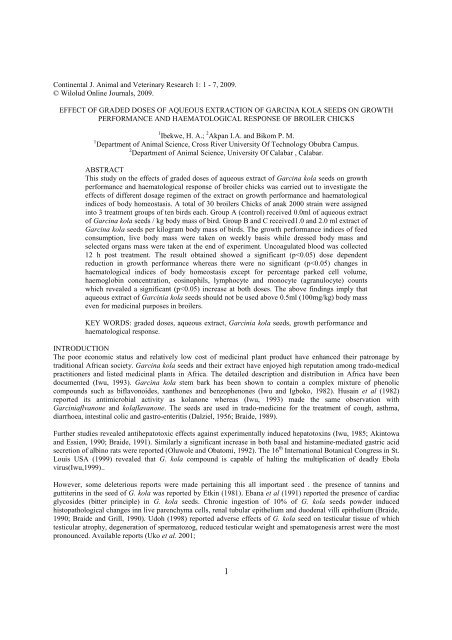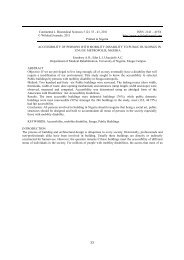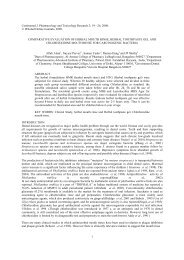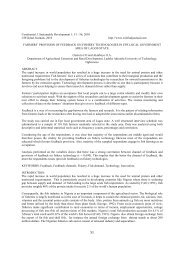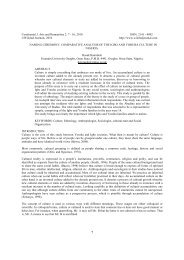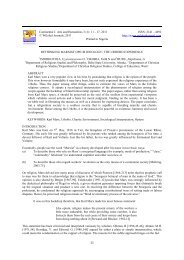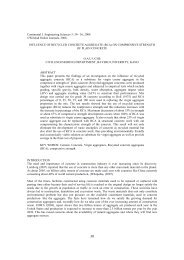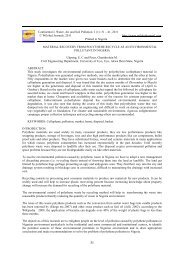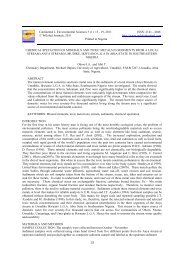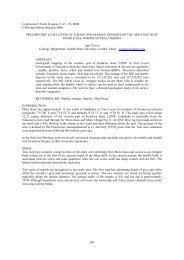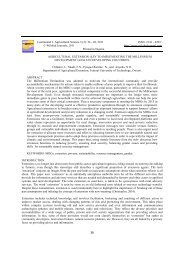Vol 1 - Continental J. Animal & Veterinay Research - Wilolud Journals
Vol 1 - Continental J. Animal & Veterinay Research - Wilolud Journals
Vol 1 - Continental J. Animal & Veterinay Research - Wilolud Journals
Create successful ePaper yourself
Turn your PDF publications into a flip-book with our unique Google optimized e-Paper software.
<strong>Continental</strong> J. <strong>Animal</strong> and Veterinary <strong>Research</strong> 1: 1 - 7, 2009.© <strong>Wilolud</strong> Online <strong>Journals</strong>, 2009.EFFECT OF GRADED DOSES OF AQUEOUS EXTRACTION OF GARCINA KOLA SEEDS ON GROWTHPERFORMANCE AND HAEMATOLOGICAL RESPONSE OF BROILER CHICKS1 Ibekwe, H. A.; 2 Akpan I.A. and Bikom P. M.1 Department of <strong>Animal</strong> Science, Cross River University Of Technology Obubra Campus.2 Department of <strong>Animal</strong> Science, University Of Calabar , Calabar.ABSTRACTThis study on the effects of graded doses of aqueous extract of Garcina kola seeds on growthperformance and haematological response of broiler chicks was carried out to investigate theeffects of different dosage regimen of the extract on growth performance and haematologicalindices of body homeostasis. A total of 30 broilers Chicks of anak 2000 strain were assignedinto 3 treatment groups of ten birds each. Group A (control) received 0.0ml of aqueous extractof Garcina kola seeds / kg body mass of bird. Group B and C received1.0 and 2.0 ml extract ofGarcina kola seeds per kilogram body mass of birds. The growth performance indices of feedconsumption, live body mass were taken on weekly basis while dressed body mass andselected organs mass were taken at the end of experiment. Uncoagulated blood was collected12 h post treatment. The result obtained showed a significant (p
Ibekwe, H. A et al: <strong>Continental</strong> J. <strong>Animal</strong> and Veterinary <strong>Research</strong> 1: 1 - 7, 2009.Adediji et al, 2006) maintain no-significant changes in haematological parameters assayed except for lymphocyteand monocyte which showed a significant increase in number.The report of Adedeji et al (2006) that pullets can tolerate (2-5)% inclusion levels of Garcinia kola seed in the feedwithout compromising the body mass calls for more clarification since birds are food (meat/egg) producing animal.The conflicting reports of this seed on body mass of animal when different concentration and dosages were usedmake this study imperative. Broiler enterprise is solely embarked upon for meat production purposes. Therefore anymaterial intended for feed replacement or theraputic uses which compromise body mass and homeostasis must behandled with caution by determining the optimum dose range of administration.This study is therefore set up to ascertain the effects of graded doses of aqueous extract of Garcinia kola seed ongrowth performance and haematological response of broiler chicks with the aim of determining the optimum doserange.MATERILS AND METHODS:i. Preparation of Garcinia kola seed powder and extract:Garcinia kola seed weighing 1000grams were purchase from Marian market, Calaba in June 2004.. The seed weresun dried for 24 h to ease the removal of the testa. The seeds were sliced with sharp kitchen knife to increase thesurface area of the seeds exposed to drying. The drying was consummated in an electric oven (Gallenkamp gradeUSA). The dried seeds were ground to powder by a motor powered milling machine.Fifty grams of the powder was soaked in 250ml of clean water and left to stand for 48 h but was 250ml subjected tovigorous steering every 12 h interval. The fifty grams of Garcinia kola seed powder to250ml is equivalent to 1 gramin 5ml or 1000mg in 5ml of water. The mixture was filtered using a musclin cloth and the volume of filtrate andmass of residue recovered. The filtrate was evaporated to dryness weighed, and redissolve in 50ml of water readyfor administration to animals.ii. <strong>Animal</strong> and animal treatments:A total of 30 broiler chicks anak 2000 strain were assigned into 3 treatment groups of 10 broilers each. Group Areceived 0.0ml aqueous extract of Garcinia kola. Group B and C received 1.0ml or 200mg/ml and 2.0ml or400mg/ml of aqueous extract of Garcinia kola respectively. The extract was administered orally to each bird once aday using 5ml syringe without needle. The administration lasted for 4 weeks and live mass and feed consumptionwere recorded while the dressed mass and selected organ’s mass were taken after the birds were slaughtered anddressed.iii. Collection of blood Sample:Blood was drawn from each broiler chick 12 hours post administration of extract by decapitation and carefullytransferred into bijou sample bottles containing ethylenediamine tetra acetic acid (EDTA) anticoagulant.Haemoglobin concentration (Hbmg/ml) was determined by the cyanomethaemoglobin method using a Beckmanmodel spectrophotometer. Erythrocytes (RBC) were counted with an improved Neuberger’s haemcytometer. Totalleucocyte (WBC) count and parked cell volume (PCV) were measured with the QBCII centrifugal haematologysystem (Becton Dickinson Co. USA). The differential leucocyte count was carried out by staining the blood smearwith Leishman’s stain and the number of each cell counted. The erythrocyte indices of mean corpuscular volume(MCV), mean corpuscular haemglobin (MCH)and mean corspucular haemoglobin concentration (MCHC) werecalculated according to (Jain, 1986).STATISTICAL ANALYSISThe Student’s T-test was used to compare the significance of differences between control and treated groups whileanalysis of variance was used to compare significance of difference among and within groups of treatments(Nwabuoike, 1986).2
Ibekwe, H. A et al: <strong>Continental</strong> J. <strong>Animal</strong> and Veterinary <strong>Research</strong> 1: 1 - 7, 2009.RESULTSTable 1: Proximate composition of basal feed.Proximate fractionPercentage compositionMoisture content 10.50Dry matter 89.59Crude protein 10.00Crude fibre 7.20Ether extract 7.00Crude Ash 1.20Nitrogen free Extract 64.10Metabolizable Energy13.15KJ/gTable 2: Proximate composition of Garcinia kola seedProximate FractionPercentage CompositionMoisture content 14.60Dry matter 85.40Crude protein 0.58Crude fibre 0.10Ether extract 3.00Crude Ash 5.00Nitrogen free Extract 76.72Table 3: Mass and Yield of Garcinia kola seed.PowderResidueFiltrateExtractReconstitutionConcentration50g38g12g10g10g in 50ml of water200mg/mlTable 4: Weekly Average feed intake (kg)Treatment A B CAge (weeks)4 0.61 0.60 0.615 0.95 0.95 0.966 1.14 1.11 1.047 1.26 1.28 1.26Mean 0.99 a ±0.28 0.99 a ±0.29 0.97 a ±0.27Treatments (A: 0.00ml; B: 1.00ml; C: 2.00ml)The mean in the same row with different superscript differ significantly (p
Ibekwe, H. A et al: <strong>Continental</strong> J. <strong>Animal</strong> and Veterinary <strong>Research</strong> 1: 1 - 7, 2009.Table 5: Average final live Mass of birds.TreatmentsBody MassA : 2.40±0.65 aB : 2.10±0.55 bC : 2.00±0.53 bMean with the same row with different superscript differ significantly (p
Ibekwe, H. A et al: <strong>Continental</strong> J. <strong>Animal</strong> and Veterinary <strong>Research</strong> 1: 1 - 7, 2009.Table 4 showed weekly feed intake of broiler chicks orally dosed with graded levels of aqueous extract of Garciniakola seed. There was no significant (p>0.05) change in feed consumption of treated birds (0.99±0.29; 0.97±0.13)kgrelative to control (0.99±0.28kg) birds. This method of administration circumvents the bitter taste and sticky natureof fresh seed of Garcinia kola which results to refusal and utilization of feed by birds.Table 5 showed the final live mass in kg of broiler chicks orally fed with graded dose of aqueous extract of Garciniakola seeds. There was a significant (p0.05) changes in most of thehaematological parameters assayed except for haemoglobin concentration (g/100ml) which increase significantly(p0.05) changes in total RBC and WBC counts relative to control birds.DISCUSSIONAqueous extract of Garcinia kola seed caused a significant (p
Ibekwe, H. A et al: <strong>Continental</strong> J. <strong>Animal</strong> and Veterinary <strong>Research</strong> 1: 1 - 7, 2009.effect since even repeated evaluation of these parameters in the same treatment will show such variation. Thesedifferences are normal with such parameters (Conley, 1974). The findings of this study are at variance with thedirect variation existing among total erythrocyte count, haemoglobin concentration and parked cell volume (Schalmet al, 1975) as there was no – significant changes in erythrocyte count. This may be attributed to the complexingpower of flavonoid with metal like iron, zinc and Copper thereby making them unavailable (Siegenberg, 1991).Therefore since iron is needed for synthesis of erythrocyte it becomes difficult to have increased number oferythrocyte where there is deficiency of iron.The observed significant (p
Ibekwe, H. A et al: <strong>Continental</strong> J. <strong>Animal</strong> and Veterinary <strong>Research</strong> 1: 1 - 7, 2009.Ebana, R.U.; Madunaga, B.E.; Ekpe E.D. and Otung, D.N (1991). Microbiological exploitation of cardiacglycoside and alkaloids from Garcinia kola. Borreria Ocymoides, Kola nitida and citrus aurantifolla. A Journal ofApplied Bacteriology. 71(5): 398-401.Etkin, N.L (1981): A Hausa herbal Pharmacopoeia: Biomedical evaluation of commonly used plant medicines.Journal of Ethnopharmacology. 4:75-98.Husain, R.A; Cvegby, A.G.; Parimoo, p. and Waterman, P.G (1982). A novel Polyisopremylated benzophenonewith antimicrobial properties from the fruit of Garcinia kola . Plant Medicine. 44: 78-81.Ibekwe, H.A., Eteng, M.U> and Antigha, E (2007). Proximate and phytochemical composition of Garcinia kolaand Vernnia amygdalia. Global Journal of Agricultural Sciences. 6(2): 207-209Iwu, M.M. (1985). Atihepatotoxic constituents of Garcinia kola seeds. Experimentia. 41: 699-700Iwu, M.M. (1999). Ebola cure hope. BBC Newsletter. 16 th Botanical Congress.Iwu, M.M. (1993). Hand book of African medicina plant. CRC. Press; London. Pp183-184Iwu, M.M. and Igboko, A.O. (1982). Constituent of Garcinia kola seeds. Journal of Natural Products. Lloydia.45: 650-651Jain, N.C. (1986). Schalms Veterinary Haematology. 4 th ed, Lea and Hebiger. Piladelphia. Mascolo, N., Pinto,A and Capsso, F. (1987). Flavonoids Leuccyte migration and eicosanoid. J. Pharm. Pharmacol., Moscolo. 40: 293-295Nwabuoike, H. (1986) Fundamental of Statistics. New edition. Aba Koruna Books Oluwole, F.S and Obatomi, A.B.(1992). The effect of Garcinia kola seeds on gastric acid secretion in albino rats. Nig. J. Physiological Science., 8:115-116.Peter, J.L and Richard. C.L. (1999). Plant Biochemistry and Molecular Biology. 2 nd ed. John Wiley and Sons,New York.Siegenberg, D., Baynes, R.D., Bothwell, T.H., Macfarlean, B.J., Lamparelli. R.D., Car, N.G., Macphail, P.,Schmidt, U., Tail, A and Mayet, F. (1991). Ascorbic acid rpefents the doedse-dependent Inhibitory effect ofpolyphenols and phytate on non-heme-iron absorption. Am. J. Clin Nutri., 53(2): 537-541Udoh, F.V. (1998).effects of extract of Garcinia kola and piper guineense leaves on morphology ofreproductive organs of male rats. Phytotherapy es., 13: 226-228Uko, O.J., Usman, A. and Ataja, A.M. (2001). Some Biological activities of Garcinia kola in growing rats.Verterinarski Arhiv. 71(5): 287-297Received for Publication: 22/12/2008Accepted for Publication: 15/02/2009Corresponding Author:Ibekwe, H. A.Department of <strong>Animal</strong> Science, Cross River University Of Technology Obubra Campus..7


